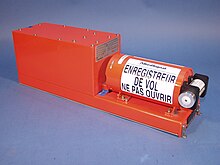
Back صندوق أسود (طيران) Arabic Qara qutu (nəqliyyat) Azerbaijani ফ্লাইট রেকর্ডার Bengali/Bangla Crna kutija BS Caixa negra Catalan تۆمارکەری فڕین CKB Černá skříňka (doprava) Czech Sort boks Danish Flugschreiber German Nigra skatolo (aviadilo) Esperanto


A flight recorder is an electronic recording device placed in an aircraft for the purpose of facilitating the investigation of aviation accidents and incidents. The device may often be referred to colloquially as a "black box", an outdated name which has become a misnomer—they are now required to be painted bright orange, to aid in their recovery after accidents.
There are two types of flight recording devices: the flight data recorder (FDR) preserves the recent history of the flight through the recording of dozens of parameters collected several times per second; the cockpit voice recorder (CVR) preserves the recent history of the sounds in the cockpit, including the conversation of the pilots. The two devices may be combined into a single unit. Together, the FDR and CVR objectively document the aircraft's flight history, which may assist in any later investigation.
The two flight recorders are required by international regulation, overseen by the International Civil Aviation Organization, to be capable of surviving the conditions likely to be encountered in a severe aircraft accident. For this reason, they are typically specified to withstand an impact of 3400 g and temperatures of over 1,000 °C (1,830 °F), as required by EUROCAE ED-112. They have been a mandatory requirement in commercial aircraft in the United States since 1967. After the unexplained disappearance of Malaysia Airlines Flight 370 in 2014, commentators have called for live streaming of data to the ground, as well as extending the battery life of the underwater locator beacons.
© MMXXIII Rich X Search. We shall prevail. All rights reserved. Rich X Search